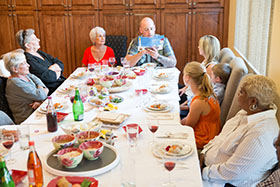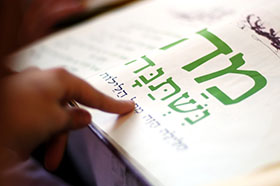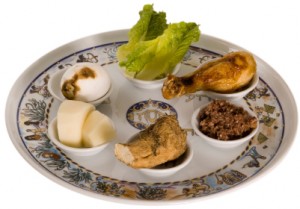
The Seder, literally ‘order’, is the ritualised meal eaten on the first two nights of Pesach (only one night in Israel). The Pesach Seder is the most consistently maintained Jewish ritual observance in the home, regardless of the level of observance of the family.
Pesach seders take an extremely wide range of forms. Each family’s seder is shaped by local and regional customs, in addition to traditions passed down from generation to generation.
The purpose of the seder is to serve as a framework for the telling of the Exodus story, while allowing each new generation to engage the narrative in a deeply personal and intimate manner. Above all, the seder is a venue for the telling of the story of our redemption from the harsh slavery in Egypt.

It is a mitzvah not only to tell the story as if from afar, but rather to relive it every year at our seder tables. In the narrative it is not ‘the Israelites’ who leave Egypt each time but ‘we’. The mitzvah is to relive the Exodus as if we were experiencing it ourselves.
Everything concerning both the conduct of the seder and the objects upon the seder table is there to evoke questions and dialogue. The questions are meant to engage not only the adults, but also the children. The singing of the song “Ma Nishtanah” (“Why is this night different?”) is a focus of the seder and is traditionally done by the youngest child present. The framework for conducting the seder is set out in the book called the Haggadah.
THE HAGGADAH

(the Hebrew text of the Haggadah has an English translation alongside it); the text in blue boxes
at the bottom of the pages is explanation of the text.
The Haggadah, literally ‘The Telling’, is the text that in its pure form has provided the foundation for the Pesach seder for thousands of years. It contains blessings, stories, instructions and everything that is needed for the participants to relive the narrative of the Exodus. It should be noted that although the Haggadah is the text of the seder, the sages teach us that it is praiseworthy to expand on the text, thus building on the tradition and personally engaging with the story.
There are many forms of Haggadot (plural of ‘haggadah’) to choose from, each representative of the many diverse communities comprising the Jewish world of today. But with all that is included within the Haggadah, one figure is either mentioned extremely rarely or not at all: Moses. For the most part, Moses is missing from the text of the Haggadah. The rabbis who created the text of the Haggadah felt that including Moses in the text would tempt people to deify him, so he is barely mentioned.
The Haggadah contains the order of the seder. The steps of the seder are spelled out in detail and their order is as follows:
- Kadesh
- Urhatz
- Karpas
- Yahatz
- Maggid
- Rachatz
- Motzi-Matzah
- Maror
- Korekh
- Shulhan Orekh
- Tsafun [Afikoman]
- Barekh
- Hallel
- Nirtzah
The seder is concluded with the hope “L’shanah haba-ah b’Yerushalayim!” – Next year in Jerusalem!
THE SEDER TABLE

There are many symbolic objects upon the seder table. There are several rabbinic meanings connected with each. However one should not be limited to the traditional view of each object. Allow yourself and your children to mentally ‘play’ with each symbol and see what new insights you can bring both to your seder and to our tradition.
On the seder plate: objects and what they represent
Maror (bitter herbs)
- the bitterness of our enslavement under the Egyptians
Charoset (a mixture of nuts and wine)
- the mortar used by us to build the Egyptian cities
Salt water
- the tears shed during our enslavement
Karpas (vegetable)
- spring, of rebirth, also that a vegetable that grows under ground can be elevated to sacredness, and a slave people to freedom
Shankbone and roasted egg
- the offerings at the Temple in Jerusalem that was destroyed in 70 C.E. The shankbone is used because God brought us out of Egypt with an ‘outstretched arm’.
The four cups of wine
- our joy and gladness; also recalling the four verses in the Torah concerning our redemption from Egypt (Exodus 6:6-7):
- “I will bring you out…”
- “I will deliver you…”
- “I will redeem you…”
- “I will take you…”
Grape juice may be used instead of wine by young children or those who do not drink wine. It is preferable to use red wine (or grape juice) rather than white.
Elijah’s Cup
- a fifth cup of wine that we set on the table in the hope that the prophet Elijah will grace our table and hearken the coming of the Messiah, a time of universal peace. Elijah’s cup also symbolizes our hope of welcoming others, especially those in need, hungry or even just lonely into our home to share in our joy during Pesach.
 Matzah (unleavened bread)
Matzah (unleavened bread)
Three matzot* are placed on the table. Why three? Two because two loaves of challah (plaited bread) are required as on every chag and Shabbat, and a third is required to be broken in two with half being hidden as the afikoman to be found at the conclusion of the meal. It is customary for an adult to hide the afikoman during the meal so that the children can find it at the end. This is another example of how important the rabbis felt it was to engage the children in the seder.
* the word matzot is the plural form of matzah (one piece of unleavened bread)
“NEXT YEAR IN JERUSALEM!”
With these words we conclude our seder. We have fulfilled a mitzvah, broken bread together, told a story…our story and perhaps…just perhaps, left the table with a few insights, not only into our tradition and history, but also into ourselves.
Our national journey from Mitzrayim (Egypt), that ‘place of narrowness,’ towards the openness of the wilderness is paralleled within our own personal lives. What journeys are we making today to take ourselves from that place of narrowness in which we may reside to the openness that awaits us?
With the second night of Pesach we start the counting of the Omer. We count off the forty-nine days till our meeting with God at Mt. Sinai and our observance of the chag of Shavuot. It is at Sinai that our newfound national freedom receives direction and purpose.
Related Pages on the BJE Website
How to Prepare a Home for Pesach
Bedikat Chametz (the Search for Leaven)
How to Make Kneidlach (soup dumplings)
LINKS TO PAGES ON OTHER SITES
Aish haTorah: Haggadah Songs
Chabad: The Haggadah
Judaism 101: Pesach Seder – How is This Night Different
Jewish Agency – The Online Haggadah
hebrewsongs.com – Pesach Songs & Music
My Jewish Learning: The Haggadah
Ohr Somayach: The History of the Haggadah
Rabbi Yitz Wyne: Passover (insights into the Haggadah and the Seder)(video)
The Family Participation Haggadah
Uncle Eli’s Haggadah (for children)


